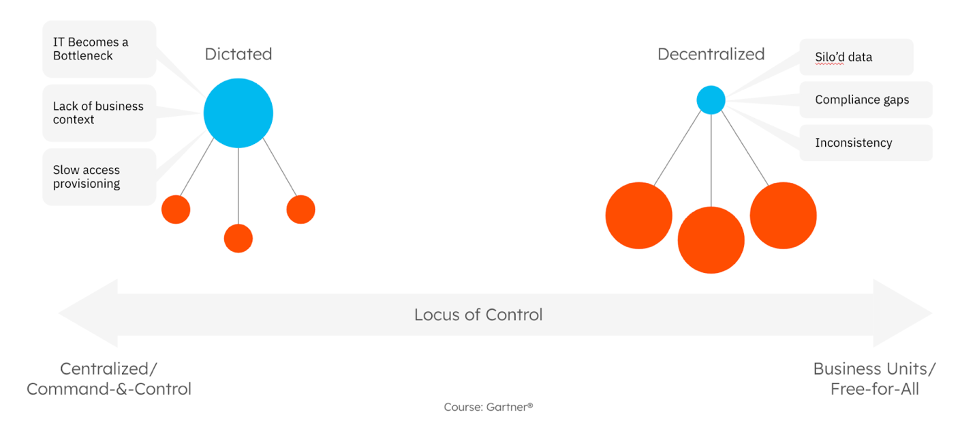
In the digital era, navigating the choppy waters of data governance poses a significant challenge for enterprises. On one end of the spectrum, a rigid command-and-control approach stifles innovation and agility, turning data management into a bottleneck rather than a boon. On the other, a laissez-faire, free-for-all strategy risks data chaos, compromising security, quality, and compliance.
This article delves into the quest for a balanced approach, highlighting the importance of federated data stewardship. It advocates for a federated model of data governance that harmonizes the need for oversight with the demand for flexibility, thereby enabling enterprise-wide sharing and innovation. Through a mix of theory, practical approaches, and enlightening case studies, we’ll explore how federated data governance not only mitigates the extremes of too-tight or too-loose data controls, but also paves the way for a more resilient and agile data governance framework. In doing so, we’ll chart a course toward achieving the ultimate goal of data governance: to empower organizations to leverage their data assets safely, efficiently, and effectively.
Business Goals for Data Governance
Effective data governance is the cornerstone of a thriving data-driven organization, aiming to strike a delicate balance between accessibility and security, between innovation and compliance. At its core, data governance sets out to achieve several critical goals. Firstly, it seeks to democratize data, making it easily and securely accessible to those who need it, thereby fueling informed decision-making across the enterprise. Yet, in the same breath, it commits to the fortress-like protection of sensitive information, enforcing stringent security measures to ward off breaches and ensure regulatory compliance. Privacy is not left behind; data governance upholds the sanctity of personal information, weaving a tapestry of policies that shield individuals’ privacy in an increasingly digital world. Moreover, it champions the cause of data quality, ensuring that the lifeblood of the organization — its data — is accurate, consistent, and reliable. Lastly, it navigates the complex web of laws, regulations, and industry standards, ensuring the organization not only survives, but thrives within its regulatory environment. In essence, data governance is the guiding light that leads organizations through the murky waters of the digital age, ensuring that they emerge not just unscathed, but stronger, more agile, and more innovative.
The Role of the Data Steward in Data Governance
Data stewardship weaves the intricate fabric of data governance, serving as its operational backbone by balancing access with security, enforcing data policies, and categorizing the vast digital ocean of information. It’s a craft that goes beyond mere management to include the meticulous curation of metadata, ensuring data quality, and providing subject matter expertise. Stewards of data navigate the complex interplay between keeping data accessible yet secure, all while upholding the organization’s data standards and practices. Often, stewardship is not confined to a singular role, but is a responsibility shared across the board, embedding data governance into the very DNA of the organization. It’s a testament to the idea that effective data governance relies not just on policies and procedures, but on the collective commitment and expertise of those who handle the data day in and day out.
Moving from Legacy Approaches to Data Governance
Navigating the terrain of traditional data governance approaches often feels like choosing between two extremes: the rigid, centralized command-and-control model, and the chaotic, decentralized free-for-all. The former places all power in the hands of IT departments, turning them into inadvertent bottlenecks. This centralization, while ensuring security, often lacks the nimbleness and contextual understanding needed for timely data access and decision-making. Conversely, the decentralized approach offers individual business units the freedom to manage their data, fostering analytical agility and responsiveness. However, this often leads to data silos, compliance oversights, and inconsistencies that can undermine the broader organizational objectives and security protocols.

The emerging paradigm shifts toward a more nuanced, delegated approach to data governance, aiming to marry the best of both worlds. This strategy envisions a shared model, where data stewardship and ownership are entrusted to those with the deepest understanding of the data’s utility, within a robust framework of security and governance guardrails. It’s a move toward true data democratization, emphasizing the secure sharing of data across sources and hybrid environments, and delegating access control to data or business owners. By specifying access rights for particular data domains and datasets, this approach seeks to ensure that data is not only accessible and usable across the enterprise, but also governed with an eye towards security, compliance, and consistency. The ultimate goal is a landscape of enterprise-wide, governed data sharing, where agility, security, and governance coexist in a balanced and effective ecosystem.
Why Federated Data Governance?
Federated data governance stands out as a transformative approach, effectively eliminating the long-standing IT bottleneck to unlock seamless data access. Supporting a self-service model, it places the power of data management directly in the hands of local stewards, sidestepping the traditional IT gatekeeping and accelerating the data access process. These stewards, embedded within their specific domains, are not only closer to the operational realities, but also equipped to manage access requests swiftly, ensuring data flows freely to those who need it most. Yet, the freedom federated governance offers does not lead to a free-for-all scenario. Collaborating closely with a centralized data governance council (DGC), stewards help forge and enforce global security and compliance guardrails, marrying localized agility with enterprise-wide consistency.
Moreover, this model adeptly addresses and eradicates gaps and inconsistencies that have plagued organizations. By centralizing the creation of security guardrails while decentralizing enforcement and access management, federated governance ensures that data access across the organization adheres to uniform policies, without stifling departmental needs or innovation. An intuitive, business-focused user interface empowers non-technical users to easily craft and apply the necessary policies and controls, further democratizing data governance. This approach not only enhances operational efficiency, but also ensures that domain-specific policies and controls are applied, aligning closely with the unique needs and challenges of each business unit. In essence, Federated Data Governance offers a scalable, flexible solution that ensures data is accessible, secure, and compliant across the enterprise, bridging the gap between centralized control and local autonomy.
Some Customer Case Studies
Case Study One
A global media and technology company faced challenges in enhancing customer experience, marketing, and operations while migrating to AWS to modernize its infrastructure. The company’s do-it-yourself approach to security and governance had failed, and the IT bottleneck in managing data access was hindering progress. By implementing a federated approach with a single platform for managed security and access policies across all analytical applications, the company achieved a breakthrough. This approach ensured consistent security and governance across the board, enabling a 360-degree view of the customer without introducing compliance risks. It not only met internal and external compliance mandates, but also eliminated the IT bottlenecks that previously limited customer and employee experiences.
Case Study Two
A healthcare payer aimed to leverage data innovation to transition into a digital business while ensuring the protection of Protected Health Information (PHI) and eliminating data security issues arising from coarse-grained access controls. The organization also sought to address the challenge of data proliferation caused by duplicating data to manage access and mitigate data exposure and IT operating inefficiencies. By focusing on sensitive data identification and fine-grained data protection, they revolutionized their approach. This offered more transparent data security and access controls and provided a comprehensive view of security, simplifying audits. The impacts were significant: reduced data proliferation, enhanced accessibility and manageability of data, ensured discovery and control of PII and other sensitive data, and drastically reduced complexity of data security management, thereby lessening the IT workload.
These case studies illuminate the business impact of shifting away from traditional data governance models toward more agile, modern solutions. By embracing managed security services and fine-grained data protection, organizations not only streamline compliance and governance but also unlock new avenues for innovation and efficiency, proving that the right approach to data governance can be a game-changer in the digital age.
Parting Words
The adoption of a federated data stewardship approach heralds a new era in data governance, blending the best of centralized oversight with the agility of decentralized management. This model ensures that governance is not just a concept but a consistently applied practice across the entire data estate, providing a uniform layer of security, privacy, and quality without stifling innovation. By breaking down the silos that traditionally impede the flow of information, it accelerates data accessibility across the organization, fostering an environment where insights and decisions are driven by timely, reliable data. Moreover, it elevates the role of the data steward from a gatekeeper to a strategic partner in data management, making it a more valuable and impactful position. The federated data stewardship approach is more than just a methodology; it’s a catalyst for transformation, enabling organizations to navigate the complexities of the digital age with confidence and agility.
